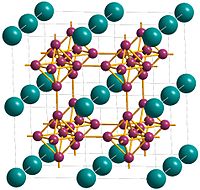Calcium hexaboride
 |
|
| Names | |
|---|---|
|
IUPAC name
Calcium hexaboride
|
|
| Other names
Calcium boride
|
|
| Identifiers | |
|
3D model (JSmol)
|
|
| ChemSpider | |
| ECHA InfoCard | 100.031.374 |
| EC Number | 234-525-3 |
|
PubChem CID
|
|
|
|
|
|
| Properties | |
| CaB6 | |
| Molar mass | 104.94 g/mol |
| Appearance | black powder |
| Density | 2.45 g/cm3 |
| Melting point | 2,235 °C (4,055 °F; 2,508 K) |
| insoluble | |
| Structure | |
| Cubic | |
| Pm3m ; Oh | |
|
Except where otherwise noted, data are given for materials in their standard state (at 25 °C [77 °F], 100 kPa).
|
|
|
|
|
| Infobox references | |
Calcium hexaboride (sometimes calcium boride) is a compound of calcium and boron with the chemical formula CaB6. It is an important material due to its high electrical conductivity, hardness, chemical stability, and melting point. It is a black, lustrous, chemically inert powder with a low density. It has the cubic structure typical for metal hexaborides, with octahedral units of 6 boron atoms combined with calcium atoms. CaB6 and lanthanum-doped CaB6 both show weak ferromagnetic properties, which is a remarkable fact because calcium and boron are neither magnetic, nor have inner 3d or 4f electronic shells, which are usually required for ferromagnetism.
CaB6 has been investigated in the past due to a variety of peculiar physical properties, such as superconductivity, valence fluctuation and Kondo effects. However, the most remarkable property of CaB6 is its ferromagnetism. It occurs at unexpectedly high temperature (600 K) and with low magnetic moment (below 0.07 per atom). The origin of this high temperature ferromagnetism is the ferromagnetic phase of a dilute electron gas, linkage to the presumed excitonic state in calcium boride, or external impurities on the surface of the sample. The impurities might include iron and nickel, probably coming from impurities in the boron used to prepare the sample.
...
Wikipedia

